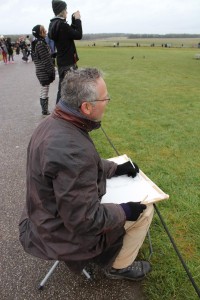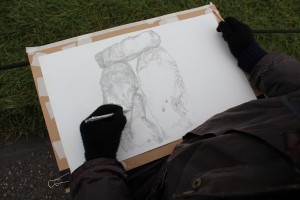Stonehenge – Sunday 23rd December
It’s a chilly damp day. The sky is various shades of grey. Dull. But nevertheless, the world has come to Stonehenge. I know that visitors from all over the globe are here as I walk through the throng of different languages and into the tunnel that passes under the road.
A Druid banner turns the end corner of the slope and into the tunnel, accompanied by the regular beat of a wooden staff on a stretched skin tambourine. This is a large group of Druids, mainly dressed in white tabards and robes with woollen cloaks over the top. A purple bright chap with a guitar and harmonica plays the procession through and visitors stand to the side looking bemused, confused and delighted.
As I get to the top of the slope a large man, head to toe in flowing green robes offers me a small piece of mistletoe from a large bunch he’s carrying. “Here you are, darling”, he says, ”Thank you. And a Happy Christmas.” I say back. “Happy Christmas” he says. Quite a few people are carrying little mistletoe sprigs along the tarmac path, clearly chuffed by their encounter with this piece of folk Britain, as am I.
I have a fond connection to mistletoe. It reminds me of my grandmother. She kept a small orchard of apple trees, dwarf trees onto which she had grafted seeds of the mistletoe. Emulating the birds by making small incisions and rubbing the berries into the bark, her apple trees were abundant with the plant and with apples. Food for us and food for the birds. Some people refer to mistletoe as a ‘parasite’ plant as it relies on the system of its host to keep it alive. However its worst offence seems to be to stunt the growth of its host, in the case of my grandmother’s apple trees, an altogether handy thing. Who wants to climb high ladders to collect the harvest? Apple trees are a regular host, but in folklore, the most prized mistletoe comes from the oak. Apparently, it’s rare. I don’t know where the sprig I’ve been given comes from but its various symbolic functions are the promotion of love, the protection from evil spirits and the keeping of the home free from lightening strikes or fire. What’s not to like?
Mark is having another session on his silverpoint portrait of the great trilithon. He’s getting very familiar with it, though how much he’s committed to memory, I really don’t know. People video and photograph over his shoulder. Some people stand right up close to him and get a photo taken with their front and his back in frame.
I can hear that along with all the international visitors here today, there is also a sprinkling of English people, which means the supermarkets aren’t holding captive every family preparing for the big day. Much nicer to be out in the open. Yes, it’s grey, but it’s not raining. Yet.
The A303 is rammed and slow. Part of the great Christmas getaway. The byway has more than a dozen vans parked up. Left over from the solstice celebrations on Friday. I wonder how many will spend their Christmas here? Stonehenge is only closed two days a year and that’s Christmases Eve and Day. There will still be people working here though. The security guards are here every day of the year and all through the cruel winter nights.
One of the EH staff starts the daily ritual of moving the guide rope, back by about three foot on the grass walkway. It’s very muddy now it’s been so wet. I’m unsure the grass can be protected much in this weather. I watch a girl, her eyes on the soupy ground as much as on the stones, delicately stepping round in light grey espadrilles. I fear they won’t be that colour when she’s made the full circuit.

